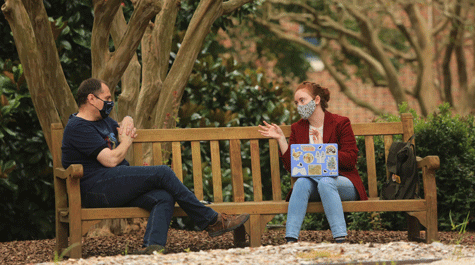W&M strategic planning to put vision into action
Returning to a strategic planning process that was paused a year ago for COVID-19, William & Mary leadership outlined updates to the final phase of planning during a virtual community conversation Monday.
Community members were invited to be part of a six-week reflection process and to provide feedback for use in the next stage, which will be called “Vision into Action.” Feedback will be collected through April 30.
“A year into pandemic, we have seen profound changes in our community – both in how we have operated and what we have accomplished,” said W&M President Katherine A. Rowe. “And this is the right time to start taking stock of how we’ve changed. So, with hope and commitment, I’m restarting the strategic planning process that we paused.
“Today’s community conversation kicks off a defined period of reflection for the community … that’s the rhythm of this restart,” she said, explaining the necessity of taking stock before setting priorities and moving to focused action.
Phase III: Vision into Action
The community conversation with Rowe on March 22 featured Peggy Agouris, provost and co-chair of the Strategic Planning Steering Committee; Carl Friedrichs, Glucksman Professor and associate director, Chesapeake Bay National Estuarine Research Reserve in Virginia; Cathy Forestell, director of neuroscience and associate professor of psychological sciences; and Suzanne Raitt, Chancellor Professor of English.
Friedrichs, Forestell and Raitt each served as co-chair of a Strategic Planning Steering Committee subcommittee that produced three environmental scan white papers earlier in the planning process —on the topics of teaching & learning, research & innovation and flourishing & engagement. Looking back on those white papers is the first step of restarting strategic planning work, Rowe said. Pandemic has served as a “stress test” for the work completed in phases I and II of the planning process. Rowe invited the whole community into this reflection process.
Speakers focused on three questions: During pandemic, how have our assumptions changed and matured? What do we want to carry forward from this year? What do we now want to lay aside?
Rowe gave a new timeline for phase III of strategic planning . After six weeks of reflection this spring, in May, the white paper co-authors will play back to the community what leadership has learned, then deliver the results of community feedback to the President’s Cabinet for focused priority-setting. The President will bring a high-level set of priorities to the Board of Visitors in the summer and formally publish these priorities together with two new key initiatives, Rowe said. One is to focus on a three-year action plan that corresponds to the challenging phase of recovery after pandemic and the other is to invite every unit and department that wishes to do so to create its own three-year action plan to support the university-wide initiatives.
What we learned, what we carry forward
Rowe added a third goal to the overall aims of strategic planning: to gain positive momentum from what’s been learned under pandemic.
Guests kicked off the conversation by exploring the three questions Rowe posed and discussing their perspectives on how the planning process has been impacted by what they’ve seen during the past year.
COVID-19’s social restrictions showed that people in the campus community like being together and on campus, which further emphasized the W&M value of belonging, Agouris said. The university learned the distinct value of convening in-person and its impact on building community, said Agouris, adding students, faculty and staff also learned how to be more flexible as conditions dictated.
Rowe asked how participants’ thinking has evolved since they worked on their white papers. Forestell commented on how well they held up and that regarding remote learning, the pandemic has provided a new level of comfort while also highlighting challenges and pitfalls.
“Some aspects of the white paper now really jump out at me,” Raitt said, discussing the issues of diversity, equity and social justice that have come to the fore in the past year and the pandemic’s more severe impacts on some populations.
As far as additions to what was previously highlighted in the papers, Raitt said that people had to make changes very fast. She added that we learned patience is important because change is hard.
“I thought that innovation in the use of virtual technology went so quickly and went so well considering how hard it was; I was really amazed,” Friedrichs said. “It’s was almost like we went five years in technology in only one year.”
Higher education’s role
Asked what may have been missed, Raitt said that while W&M flourished, it lost the kind of engagement normally felt in the community. Moving forward, Raitt added, people can use the public health example to build on increasing all forms of responsibility to one another.
Agouris mentioned the absence of many international students in the campus community was a difference that was felt, and that she has emphasized that loss as one of the things that’s been noticeably different about the past year.
Looking toward emerging from the pandemic, Agouris assessed that colleges and universities have seen their value highlighted in many ways. She mentioned that there have been numerous W&M partnerships in the community, including Raymond A. Mason School of Business students assisting local businesses and School of Education students and staff supporting local K-12 teachers and students.
“So overall, this is the silver lining in a very difficult crisis for the world, the fact that higher education emerged not only as a passive supporter but as an active contributor to the pathway towards the exit out of this pandemic,” Agouris said.
Members of the community are invited to review the white papers and provide reflections on the strategic planning website.
 Skip to main content
Skip to main content

